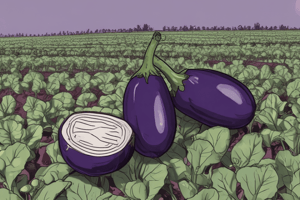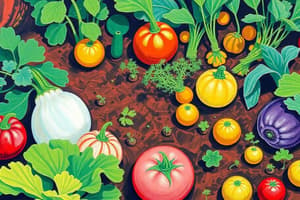Podcast
Questions and Answers
What does the term 'olericulture' specifically refer to?
What does the term 'olericulture' specifically refer to?
- The cultivation of pot herbs. (correct)
- The study of weather patterns.
- The study of soil science.
- The breeding of livestock.
In what state is a vegetable typically consumed, according to the definition provided?
In what state is a vegetable typically consumed, according to the definition provided?
- In the unripe stage. (correct)
- Dried and preserved.
- After fermentation.
- Fully ripened.
Vegetables are considered what type of food due to their vitamin and mineral content?
Vegetables are considered what type of food due to their vitamin and mineral content?
- Protective supplementary (correct)
- Energy-rich
- Primary
- Complementary
Which nutrients are peas and beans primarily enriched with?
Which nutrients are peas and beans primarily enriched with?
Which minerals are abundant in vegetables like peas, beans, spinach and bendi but lacking in cereals?
Which minerals are abundant in vegetables like peas, beans, spinach and bendi but lacking in cereals?
What dietary component is found in large quantities in amaranth, cabbage, and beans?
What dietary component is found in large quantities in amaranth, cabbage, and beans?
Which of the following is a root crop well known for its high carbohydrate content?
Which of the following is a root crop well known for its high carbohydrate content?
According to the information, what percentage does India contribute to the world's vegetable production?
According to the information, what percentage does India contribute to the world's vegetable production?
Which organization is the nodal agency in India for regulating the export and import of food products?
Which organization is the nodal agency in India for regulating the export and import of food products?
What percentage of total vegetable output in India is utilized by the processing industry?
What percentage of total vegetable output in India is utilized by the processing industry?
What is the main purpose of a home or kitchen garden?
What is the main purpose of a home or kitchen garden?
What is a primary advantage of having a kitchen garden?
What is a primary advantage of having a kitchen garden?
Where are market gardens typically located?
Where are market gardens typically located?
What factor compensates for the high cost of labor and land in market gardens?
What factor compensates for the high cost of labor and land in market gardens?
Which type of vegetable garden produces selected crops in large quantities for distant markets?
Which type of vegetable garden produces selected crops in large quantities for distant markets?
Around what are vegetable gardens for processing typically developed?
Around what are vegetable gardens for processing typically developed?
What is the primary purpose of vegetable-forcing?
What is the primary purpose of vegetable-forcing?
What structures are commonly used for vegetable-forcing?
What structures are commonly used for vegetable-forcing?
What is a specialized knowledge required for in vegetable garden for seed production?
What is a specialized knowledge required for in vegetable garden for seed production?
Where are floating vegetable gardens commonly seen?
Where are floating vegetable gardens commonly seen?
Flashcards
What is Olericulture?
What is Olericulture?
Branch of horticulture dealing with the study , production and cultivation of vegetables.
What is a Vegetable?
What is a Vegetable?
An edible herbaceous plant or its parts, typically consumed unripe and after cooking.
Vegetables as Protective Food
Vegetables as Protective Food
Vitamins, minerals, and amino acids vegetables provide, acting as supplementary dietary protection.
Which root crops are rich in carbohydrates?
Which root crops are rich in carbohydrates?
Signup and view all the flashcards
Name vegetables rich in Iron, Calcium and Vitamin K.
Name vegetables rich in Iron, Calcium and Vitamin K.
Signup and view all the flashcards
Dietary Factors from Vegetables?
Dietary Factors from Vegetables?
Signup and view all the flashcards
Types of Vegetable Gardens?
Types of Vegetable Gardens?
Signup and view all the flashcards
What is a Home or Kitchen Garden?
What is a Home or Kitchen Garden?
Signup and view all the flashcards
Advantages of a Kitchen Garden?
Advantages of a Kitchen Garden?
Signup and view all the flashcards
What is a Market Garden?
What is a Market Garden?
Signup and view all the flashcards
What is a Vegetable Garden for Processing?
What is a Vegetable Garden for Processing?
Signup and view all the flashcards
What is Vegetable-Forcing?
What is Vegetable-Forcing?
Signup and view all the flashcards
What is a Vegetable Garden for Seed Production?
What is a Vegetable Garden for Seed Production?
Signup and view all the flashcards
Floating Vegetable Garden?
Floating Vegetable Garden?
Signup and view all the flashcards
Study Notes
- Olericulture is a branch of horticulture that focuses on vegetables.
- Olericulture originates from the Latin word "Oleris" (pot herb) and the English word "culture" (cultivation).
- Vegetables are defined as edible herbaceous plants or their parts, typically consumed unripe and cooked.
- Vegetables are a good source of energy, nutrients, vitamins, minerals, carbohydrates, fats, and protein.
- Vegetables possess dietary factors such as vitamins, minerals, and amino acids, acting as protective supplementary food.
- Vegetables contribute to taste, increase appetite, and provide dietary fiber.
- Vegetables help maintain health, protect against degenerative diseases, and neutralize acids from protein and fat digestion.
- Nutrient content varies among different vegetables.
- Peas and beans are protein-rich.
- Root crops like tapioca, sweet potato, and potato are high in carbohydrates.
- Peas, beans, spinach, and bendi are sources of calcium, potassium, and iron, which are lacking in cereals.
- Amaranth, cabbage, and beans have cellulose aiding in digestion.
- Leaf and fruit vegetables provide vitamins.
Dietary Factors and Their Vegetable Sources
- Calories: sweet potato, tapioca, yam, colacasia corms, potato, Brussels sprouts, onion, garlic, immature broad bean and peas.
- Proteins: peas, double bean, winged bean, garlic, Brussels sprouts, cowpea, lema bean seeds, amaranth, leaves, drumstick leaves and menthe.
- Vitamin A (Beta Carotene): carrot, spinach, turnip green, palak, mustard green, amaranth, coriander, colacasia leaves, sweet potato, pumpkin, tomato.
- Vitamin B Complex: peas, broad bean, lema bean, garlic, asparagus, colacasia, and tomato.
- Vitamin C: turnip green, green chillies, Brussels sprouts, mustard green, amaranth, coriander, drumstick leaves, cauliflower, knoll khol spinach, cabbage, bitter gourd, and reddish leaves.
- Calcium: curry leaves, amaranth leaves, drumstick leaves, menthi, turnip, mustard green, coriander, and palak.
- Iron: drumstick leaves and fruits, amaranth, menthi, mint, coriander, spinach, palak, mustard green, lettuce, and cabbage.
- Roughages: amaranth and root vegetables.
- Vegetable milk: pea pods and cabbage leaves.
Importance of Vegetables in the National Economy
- India produces about 129 million tonnes of vegetables annually from 7.98 million ha.
- India contributes 13.4% of the world's vegetable production (2009 data).
- Vegetable crops have high export potential.
- Vegetables worth Rs 4431 crores are exported annually in fresh and processed forms.
- APEDA regulates the export and import of food products.
- Traditional vegetables: onion, potato, bhendi, bitter gourd, and chillies.
- Nontraditional vegetables: asparagus, celery, paprika, sweet corn, baby corn, beans, peas and cherry tomato are short-listed by APEDA for export.
- 77% of onion production is exported, earning foreign exchange.
- Onions and traditional vegetables are imported by Gulf countries, Singapore, Malaysia, Sri Lanka, Bangladesh, and Nepal.
- Non-traditional vegetables are imported by Australia, European countries, and Southeast Asian and Gulf countries.
- Only 1% of total vegetable output is utilized by the processing industry.
- Inadequate preservation and storage leads to a 25% loss of vegetables.
- Improving post-harvest techniques can ensure year-round availability.
Types of Vegetable Gardens
- Vegetable gardens are classified into 7 types based on their purpose:
- Home or Kitchen Gardens: Vegetable crops are grown in the backyard to meet the family's daily needs; layout varies among individuals, city gardeners use intensive methods.
- Advantages of kitchen gardens: recreation, exercise, hobby, reduces expenditure, trains children, provides fresh, market-infection-free vegetables.
- Market Gardens: Vegetables are produced for the local market, located 15-20 km from a city, cropping based on local demand, intensive cultivation.
- Market gardeners aim to grow early varieties, high land/labour costs offset by city compost, sludge, water, and high returns.
- Truck Gardens: Selected crops are produced in large quantities for distant markets, more extensive cultivation than market gardens.
- Commodities are sold through middlemen, location depends on soil and climate.
- Vegetable Gardens for Processing: Gardens are located near processing factories, growing specific varieties for canning, dehydration, or freezing, specializing in bulk vegetables.
- Heavier soil is preferred for continuous high yield, prices are on fixed contracts.
- Vegetable-Forcing: Producing vegetables out of season using glass and plastic houses, common crops include tomato and cucumber.
- Used in temperate regions, special varieties are developed, growing summer vegetables on riverbeds in winter with organic manure is also a type of vegetable forcing.
- Vegetable Gardens for Seed Production: Requires thorough knowledge of vegetable crops.
- Needed knowledge of growth habits, pollination, and isolation distances.
- Proper seed handling, curing, threshing, cleaning, grading, packing, and storage is vital. - Registered and certified seeds are multiplied by growers, expanding industry in India.
- Floating Vegetable Gardens: Floating gardens are seen on Dal Lake in Kashmir.
- Supplied to Srinagar using roots of Typha grass as a base, seedlings are transplanted on leaf compost and inter-cultural operations are done from boats.
Studying That Suits You
Use AI to generate personalized quizzes and flashcards to suit your learning preferences.




